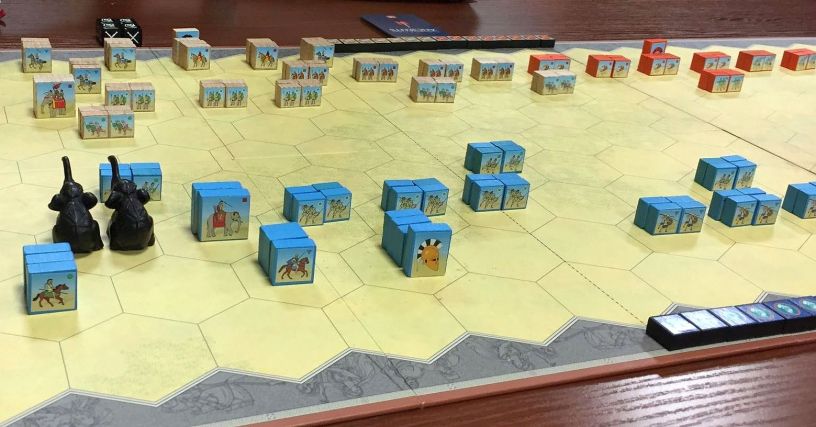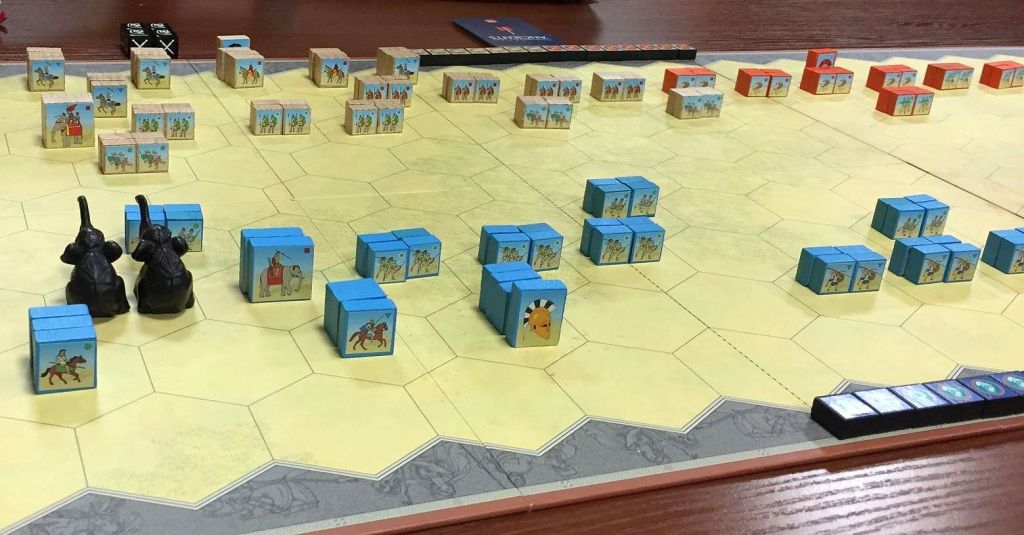Recently much of my time is devoted to the new releases – games like Imperial Struggle, Versailles 1919 or never-ending story of Gloomhaven. Still, I manage to find time for my favorite light wargame – C&C Ancients – and squeeze a scenario or two into the busy boardgames schedule.
I played so far all official scenarios from Commands Colors Ancients and I have special preference for EPIC games. They are not only large and with grand scale, allowing for much more maneuverability and tactical opportunities. Simply, you cannot win them by sheer luck as number of Victory Banners needed is usually pretty significant. Also, the importance of leader is much better underlined here – with three leaders on double-sized map you really have a lot of your forces which are not directly led by generals.
The Scenario
What we have chosen is one of the most balanced and large battles of antiquity (pity, a clash pretty obscure to nowadays boardgamers). But what else can be expected from Diadochai, successors to Alexander the Great, trying to dived the known world between themselves and carve-out a kingdoms for each other. What we had in mind was of course battle of Paraitacene (317 BC).
By 318 BC the Successors had formed two competing alliances: the ‘Royalists’ who claimed to fight to maintain the empire for Alexander’s infant sons, and a rival coalition that sought to claim their own independent kingdoms. The opposing Successor Armies in Asia—one commanded by Antigonus, the other by Eumenes—met in battle at Paraitacene in 317 BC.
Antigonus was by now the most powerful of the Diadochi but Eumenes had the backing of Alexander’s heirs and a large war chest, though the fact that he was a Greek and not a Macedonian was a major handicap. Antigonus fielded 28,000 infantry and 11,000 horse. Eumenes’ force of 35,000 foot and 6,000 horse included the veteran Silver Shields who had fought with distinction in all of Alexander’s campaigns.
The battle opened with Antigonus’ light horse attacking Eumenes right. This attack was wrecked by Eumenes’ heavy cavalry. Meanwhile in the center, the Silver Shields drove back Antigonus’ phalanx. Antigonus’ army was on the ropes when he pulled off a stroke that evened the score. He charged through a gap and was successful in routing Eumenes’ left flank. Both sides at this point were exhausted and returned to their camps. Antigonus claimed victory but realistically the battle was a draw and a final resolution would be at Gabiene, a year later.
The Session Report
One more anecdote before we proceed withe the report. While I think blocks are great for the C&C positions, I sometimes tend to spice the game up in a specific way. On the pictures of that scenario you may see that the Eumenes’ elephants were actually substituted for miniatures. Well, that was my souvenir form the trip to Thailand (long time ago 😦 ) – instead of buying cheap trash I invested in 6 beautifully carved miniatures of those beasts. Fits perfectly on the hexes!
There were three of us to play so we rolled in order to determine the sides. In the end we had following set-up:
- Marcin – leading Antigonus and his army fighting “for the peace in the empire”
- Lukasz – leading Eumenes and his army fighting for “the rightful heir to the throne”; I was a subordinate, responsible for the weak left wing of the Eumenes army, with task to hold on as long as possible!
The main actions of the game were:
- Leading the left, weaker Eumenes’ wing I had to repeal constant attacks of Marcin’s crack troops under Antigonus command. In the end I did reasonably well, managing to keep the losses of both sides on the same level and allowing precious time for Lukasz masterful plan.
- Lukasz, in overall command of our forces, slowly regrouped “brittle ancient tanks” (elephants 🙂 ) to the center and when both phalanx lines started to close on each other, sprung the trap with Mounted Charge.
- That was one of the most effective and efficient attacks of those beast I have ever seen – two units in one turn killed four, full strength, supported Heavy Infantry detachments. That was a turning point of the game.
- Then, a slow, methodical mop up action of Antigonus forces ensued. The scenario stipulates that victory margin of at least 2 banners is needed to claim victory. And so we achieved it.
Conclusions
Playing EPIC CCA is always great fun. Paraitacene scenario is definitely one among my favorite ones – it features such a number of Heavy & Medium Infantry as in no other battle – 12 on Antigonus side and 10 on Eumenes. The wings composition is very interesting, with strong mix of cavalry and elephants. And the banner count – 15 – requires of you a full and total destruction of enemy to win. Just breaking one wing is not enough.
More to come – we already have idea for another scenario which – once played – I will gladly share too!





Excellent session report! I love all things diadochai.
LikeLiked by 1 person
Diadochai battles and the period itself are one of the most interesting epochs in human history. I am glad you like it!
LikeLike